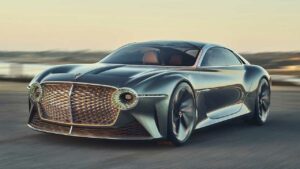Bentley has confirmed that it will utilize Mobileye’s SuperVision technology in its upcoming electric vehicle (EV). This technology, which has also been confirmed for the Porsche e-Macan on the same platform, incorporates 11 cameras, Mobileye’s EyeQ5 chip, and crowd-sourced high-definition maps. It enables level-two-plus autonomy, allowing for hands-off, eyes-on driving.
EV
Initially, the Bentley EV will offer partial hands-off driving on motorways and automated parking, with fully autonomous capabilities expected to be introduced later. Mobileye has stated that SuperVision allows for level-three autonomy, enabling hands-free and eyes-off driving on motorways.
The development of the 1.2 software within the Volkswagen Group, which includes Bentley, Porsche, and Audi, has experienced delays, affecting the release of the Bentley EV, Porsche e-Macan, and Audi Q6 E-tron on the shared platform.
The approval of the 1.2 software, specifically designed for premium cars within the Volkswagen Group, is now being overseen by Peter Bosch, former Bentley manufacturing head and current head of the Cariad software unit.

Power
AS MENTIONED BY VOLKSWAGEN GROUP CEO OLIVER BLUME, the PPE (Premium Platform Electric) electric architecture, which the Bentley EV will utilize, can deliver up to 939bhp of power.
Bentley has plans to introduce five new electric cars within five years, starting with the unveiling of the first model in 2025. According to Bentley CEO Adrian Hallmark, the EVs will not only be electric vehicles but also aim to shape a new segment in the market.
Pros of Bentley utilizing Mobileye’s SuperVision technology in their EV:
- Advanced Autonomous Features: The SuperVision technology, with its 11 cameras, EyeQ5 chip, and crowd-sourced high-definition maps, enables hands-off, eyes-on level-two-plus autonomy. This can enhance the driving experience by providing advanced autonomous features such as partial hands-off driving on motorways and automated parking.
- Safety and Convenience: Autonomous features can improve safety by reducing the risk of human error. Automated parking can make parking more accessible and more convenient for Bentley owners.
- Incremental Product: Bentley’s EV is positioned as an incremental product which builds upon the existing lineup while offering a new and innovative driving experience. This suggests that integrating autonomous technology could enhance the overall product offering.
- Segment Creation: Bentley aims to shape a new segment with its electric vehicles. By incorporating advanced autonomous features, Bentley can differentiate itself in the market and potentially attract customers looking for luxury electric vehicles with autonomous capabilities.
Cons of Bentley utilizing Mobileye’s SuperVision technology in their EV:
- Development Delays: The delay in developing the 1.2 software within the Volkswagen Group has affected the release of the Bentley EV, along with the Porsche e-Macan and Audi Q6 E-tron on the same platform. Delays can impact customer expectations and market competitiveness.
- Reliance on Software: The success and performance of the autonomous features in the Bentley EV heavily depend on the software’s development and stability. Any software-related issues or bugs could affect the functionality and user experience.
- Cost: Integrating advanced autonomous technology like SuperVision can potentially increase the overall cost of the vehicle. This might make the Bentley EV less accessible or appealing to some customers due to the higher price point associated with such technology.
- Limited Autonomous Capabilities: While SuperVision enables level-two-plus autonomy and promises level-three capabilities on motorways, it’s important to note that complete, fully autonomous driving (level-four or level-five) may not be available in the initial release. This means the hands-off, eyes-on autonomy might have limitations, and customers should be aware of these constraints.
Conclusion
Bentley’s decision to incorporate Mobileye’s SuperVision technology in their upcoming electric vehicle (EV) brings several potential benefits and considerations.
On the positive side, the advanced autonomous features enabled by SuperVision, such as partial hands-off driving on motorways and automated parking, can enhance the driving experience, improve safety, and offer convenience to Bentley owners. The integration of autonomous technology also aligns with Bentley’s goal of creating an incremental product that shapes a new segment in the market, potentially attracting customers looking for luxury electric vehicles with autonomous capabilities.
Challenges
However, there are also some challenges and considerations to keep in mind. Delays in software development within the Volkswagen Group, which includes Bentley, Porsche, and Audi, have affected the release timeline of the Bentley EV. Reliance on software stability and development introduces the possibility of bugs or issues that could impact the functionality and user experience. The cost associated with advanced autonomous technology may also be a factor, potentially making the Bentley EV less accessible to some customers.
Additionally, while SuperVision enables impressive level-two-plus autonomy and promises level-three capabilities on motorways, it’s important to note that complete, fully autonomous driving (level-four or level-five) may not be available initially. This means that the hands-off, eyes-on autonomy provided by SuperVision might have certain limitations, and customers should be aware of these constraints.
Success
Ultimately, the successful implementation of Mobileye’s SuperVision technology in the Bentley EV will depend on various factors, including software development, user acceptance, and market demand. Only time will tell how well customers will receive Bentley’s integration of autonomous features and how it will shape the brand’s future in the electric vehicle market.




































